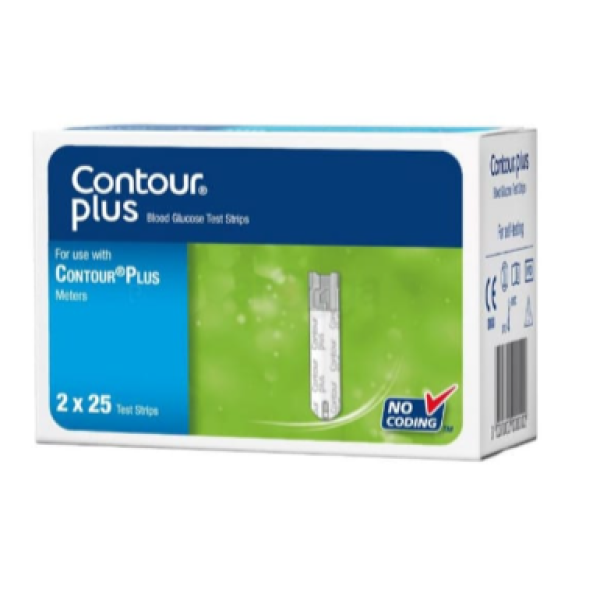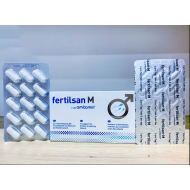
New
Contour Plus Blood Glucose Strip 25's Pack
Tk1,380
- Stock: In Stock
- Brand: Square Pharmaceuticals
- Product ID: Test Strips
0 Pcs sold
339 Interested
100% Secure Payment

Description
A glucose meter, also referred to as a "glucometer", is a medical device for determining the approximate concentration of glucose in the blood. It can also be a strip of glucose paper dipped into a substance and measured to the glucose chart. It is a key element of glucose testing, including home blood glucose monitoring (HBGM) performed by people with diabetes mellitus or hypoglycemia. A small drop of blood, obtained from slightly piercing a fingertip with a lancet, is placed on a disposable test strip that the meter reads and uses to calculate the blood glucose level. The meter then displays the level in units of mg/dL or mmol/L.
Since approximately 1980, a primary goal of the management of type 1 diabetes and type 2 diabetes mellitus has been achieving closer-to-normal levels of glucose in the blood for as much of the time as possible, guided by HBGM several times a day. The benefits include a reduction in the occurrence rate and severity of long-term complications from hyperglycemia as well as a reduction in the short-term, potentially life-threatening complications of hypoglycemia.
How to choose blood glucose meter: If you have diabetes, you'll likely need a blood glucose meter to measure and display the amount of sugar (glucose) in your blood. Exercise, food, medications, stress and other factors affect your blood glucose level. Using a blood glucose meter can help you better manage your diabetes by tracking any fluctuations in your blood glucose level.
Many types of blood glucose meters are available, from basic models to more-advanced meters with multiple features and options. The cost of blood glucose meters and test strips varies, as does insurance coverage. Study your options before deciding which model to buy.
Choosing the right meter: When selecting a blood glucose meter, it can help to know the basics of how they work. To use most blood glucose meters, you first insert a test strip into the device. Then with a special needle, you poke a clean fingertip to get a drop of blood. You carefully touch the test strip to the blood and wait for a blood glucose reading to appear on the screen.
When used and stored properly, blood glucose meters are generally accurate in how they measure glucose. They differ in the type and number of features they offer. Here are several factors to consider when choosing a blood glucose meter:
Since approximately 1980, a primary goal of the management of type 1 diabetes and type 2 diabetes mellitus has been achieving closer-to-normal levels of glucose in the blood for as much of the time as possible, guided by HBGM several times a day. The benefits include a reduction in the occurrence rate and severity of long-term complications from hyperglycemia as well as a reduction in the short-term, potentially life-threatening complications of hypoglycemia.
How to choose blood glucose meter: If you have diabetes, you'll likely need a blood glucose meter to measure and display the amount of sugar (glucose) in your blood. Exercise, food, medications, stress and other factors affect your blood glucose level. Using a blood glucose meter can help you better manage your diabetes by tracking any fluctuations in your blood glucose level.
Many types of blood glucose meters are available, from basic models to more-advanced meters with multiple features and options. The cost of blood glucose meters and test strips varies, as does insurance coverage. Study your options before deciding which model to buy.
Choosing the right meter: When selecting a blood glucose meter, it can help to know the basics of how they work. To use most blood glucose meters, you first insert a test strip into the device. Then with a special needle, you poke a clean fingertip to get a drop of blood. You carefully touch the test strip to the blood and wait for a blood glucose reading to appear on the screen.
When used and stored properly, blood glucose meters are generally accurate in how they measure glucose. They differ in the type and number of features they offer. Here are several factors to consider when choosing a blood glucose meter:
- Insurance coverage. Check with your insurance provider for coverage details. Some insurance providers limit coverage to specific models or limit the total number of test strips allowed.
- Cost. Meters vary in price. Be sure to factor in the cost of the test strips, as these will represent the majority of the cost in the long term.
- Ease of use. Some meters are easier to use than others. Are both the meter and test strips comfortable and easy to hold? Can you easily see the numbers on the screen? How easy is it to get blood onto the strips? How much blood is required?
- Special features. Ask about the features to see what meets your specific needs. Special features may include large, easy-to-handle buttons and test strips, illuminated screens, and audio, which may be useful for people with impaired vision.
- Information storage and retrieval. Consider how the meter stores and retrieves information. Some can track time and date of a test, the result, and trends over time. Some meters offer the ability to share your readings in real time with your healthcare provider with a smartphone app. Or some may offer the option to download your blood glucose readings to a computer, then email the test results to your doctor.
- Support. Most meter manufacturers include a toll-free number that you can call for help. Look for a meter that includes clear instructions that demonstrate the correct way to use the meter. Some manufacturers offer users manuals on their websites.
Storage Conditions
Store the test strip container and meter in a cool, dry place such as a bedroom. Refer to the test strip package insert for test strip storage and system operating conditions.













%20Pvt.%20Ltd./Movicol-Oral-Powder-190x190.jpg)
